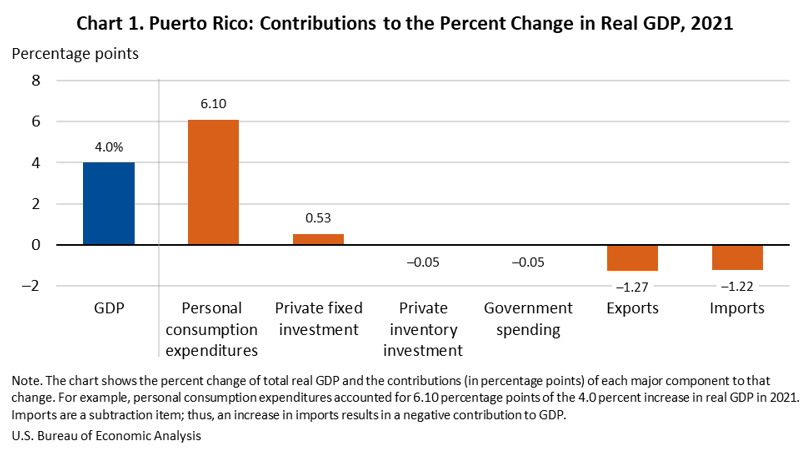Real gross domestic product (GDP) for Puerto Rico increased 4.0 percent in 2021 after decreasing 6.2 percent in 2020, according to statistics released today by the U.S. Bureau of Economic Analysis.
The increase in real GDP in 2021 primarily reflected an increase in personal consumption expenditures. Private fixed investment also increased. These increases were partly offset by decreases in exports, private inventory investment, and government spending. Imports, which is a subtraction item in the calculation of GDP, increased.
In 2021, the Puerto Rico economy was affected by the continued federal government response related to the COVID–19 pandemic. Central and municipal governments and consumers were supported by federal payments. Expenditures funded by these payments are reflected in the GDP estimates. However, the full effects of the pandemic cannot be quantified in BEA statistics for Puerto Rico, because the impacts are generally embedded in the data sources used to estimate the components of GDP.
Real personal consumption expenditures increased 11.2 percent. PCE was supported by government assistance payments distributed to households. PCE goods increased 17.1 percent, and spending on services increased 11.6 percent.
These increases were partly offset by “net foreign travel,” which equals foreign travel expenditures by Puerto Rico residents less expenditures in Puerto Rico by nonresidents. PCE goods and PCE services include spending in Puerto Rico by residents and nonresidents (e.g., tourists); nonresident spending is subtracted through the estimates of “net foreign travel,” so the PCE aggregate reflects only spending by Puerto Rico residents.
- The increase in PCE goods reflected widespread growth across both nondurable and durable goods. According to statistics published by the Economic Development Bank for Puerto Rico (EDB), unit sales of motor vehicles increased 35.9 percent.
- Within PCE services, the leading contributor to the increase was food services and accommodations. According to statistics published by the EDB, total hotel (including “paradores”) registrations increased 103.7 percent.
- Net foreign travel subtracted from PCE growth as nonresident spending on PCE goods and PCE services in Puerto Rico increased.
Real private fixed investment increased 4.0 percent, reflecting increases in equipment investment and structures investment. These increases were partly offset by a decrease in intellectual property products.
Real exports decreased 1.9 percent, reflecting a decrease in exports of goods that was partly offset by an increase in exports of services.
Real imports increased 2.5 percent, reflecting an increase in imports of goods.
Real government spending decreased 0.4 percent, reflecting decreases in spending by the federal government and municipal governments. Federal government spending decreased 3.0 percent, reflecting declines in disaster recovery activities associated with the 2017 hurricanes. Municipal government spending decreased 3.5 percent, following continued declines in appropriations from the Commonwealth government. Central government spending increased 1.4 percent, supported by federal payments related to the COVID-19 pandemic.
For more information, read the full release.
